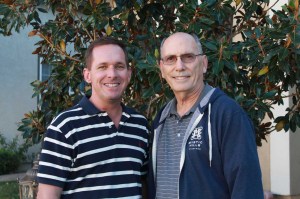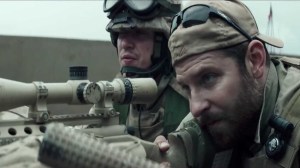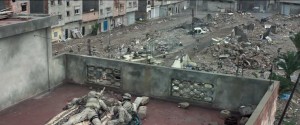
American Sniper tells the story of Navy SEAL Chris Kyle (Bradley Cooper), a sniper whose skills earned him the moniker “Legend,” and his struggles to leave the war behind as he alternates between four tours of duty and time with his wife and family stateside.
According to his longtime editor Joel Cox, director Clint Eastwood works much the same way on all his films, except that American Sniper was the second film shot on the Alexa camera that the director first used on Jersey Boys. The director loves the freedom of the steadicam, but when shooting film the camera can only carry a four-hundred foot magazine before the crew must take time to reload. Working digitally, Eastwood can run the camera longer, even pick up a scene without cutting, which allows him to keep the actors in the moment. It also means he can shoot more footage than in the past.
“This gave us more takes to work with, but he would end up printing the same amount,” shared Cox. “Clint made the comment before we started that he felt this film was going to be created in the editing room because of the style of film that it is – going back and forth between home and the war in Iraq. The tempo and timing would all be done in the editing.”
Editor Gary Roach started out as an apprentice on the editorial team. As he came up through the ranks, Roach accompanied Cox up to Carmel to edit. “For 10 years, I literally sat behind Clint and Joel, which was an amazing opportunity,” Roach said. By the time Roach started editing with Cox, he was so familiar with their process and what the director liked that it made the transition to cutting seamless.

Cox added that he was trained through the studio system in the various elements of making a film editorially – from effects to music to dialog. “Throughout that process it gave me a great understanding of when you put something together, you’re creating,” Cox said. “There’s a timing and tempo to it. Gary watched me. I watched some of the great film editors of all time working at Warner Brothers. Editing is watching people who really have an understanding of the art of editing and the technical.” Through editing, he learned how to manipulate the audience without its even knowing.
Both editors feel fortunate working for Eastwood because he allows the first assembly of the film to be more than a rough cut. The director believes in following his first instincts when directing and wants the editors to do the same when editing, without second-guessing themselves. Much like when actors lose their spontaneity after multiple takes, the editors believe that the first instinct is the truest.
“Clint allows us to put the film together based on what we see,” explained Cox. “He gave me advice years ago about my first instincts, and I’ve passed it on to Gary. ‘You look at the film that I send you and put together what you think works. Then after that, we can do anything, but I don’t want to compromise what your first instincts are.’”
The first edit of a film is the foundation for the passes that come afterwards. “I think it’s my job as an editor to take all the film that the director shot – and sometimes they try things – and make it work to the best of my ability, so they can see everything they shot working,” said Cox. “If I start making decisions – well that doesn’t work so I’m not putting it in – the director is going to want to see it. As you put it in, you are going to have to recut the whole scene. Why not do it in the first place?”
 According to Cox, the problem with opening up the film and adding shots is that once you start doing that, you lose the tempo of the film. Because production shoots out of sequence, Cox and Roach treat each scene in a movie as its own little film. The art of editing is being able to pick up a scene in the middle of the film and know that scene is going to work.
According to Cox, the problem with opening up the film and adding shots is that once you start doing that, you lose the tempo of the film. Because production shoots out of sequence, Cox and Roach treat each scene in a movie as its own little film. The art of editing is being able to pick up a scene in the middle of the film and know that scene is going to work.
Eastwood normally shoots for a month or six weeks. Because the editors have worked with him for such an extended period, post moves quickly. They usually have their cut to show the director in about a week after the shoot wraps, though this film took a bit longer because of the amount of footage. “There were some very intense war scenes that had a lot of coverage,” shared Roach. “We wanted to make sure that we got all the best material and put it together the best it could be.”
Although editing might have taken slightly longer than normal on this film, the 750-800 visual effects had the potential to adversely affect the schedule. Originally a couple of houses were working on the show, but more VFX vendors were brought in to meet the deadline. “After the studio saw the film for the first time, they were very gung-ho and excited,” commented Roach. “They wanted to release it this year, so they did whatever they had to do as far as hiring more people for visual effects, to get it done.”
Fortunately the visual effects were timed for the cut, so they could all be dropped in without changes except for one shot in which a rocket launcher is fired. It was an effect that they always knew would be adjusted. “When we cut that we weren’t exactly sure how fast those rockets go, so we had a couple variations for the speed of the rocket,” said Roach. “It changed a few frames from our original cut.”
Roach noted that the last battle scene, which contained footage that Eastwood shot as well as second unit footage, was a lot of work to edit in terms of volume, but that was not the major challenge. Every film lends itself to its own style and tempo, so if there was a challenge editing, it was balancing the emotion in the war sequences against the emotion at home.
“The amount of time spent back and forth – we would not let the audience get to a position where it was dragging,” revealed Cox. “You just get comfortable and see what’s going on and bang, you’re back in war and then it’s the other way around. It was a balance. Truly playing with that balance of tempo.”
Perhaps the biggest validation that the filmmakers garnered came from the emotional reactions of Kyle’s friends and family after they experienced the portrayal of his struggles on screen. Roach noted, “It was very touching to know that Bradley became Chris Kyle.”





